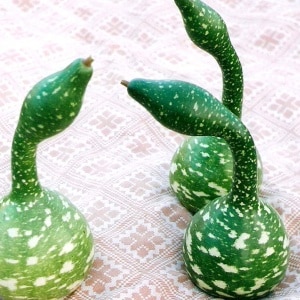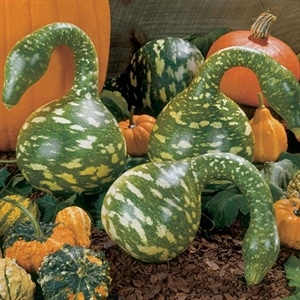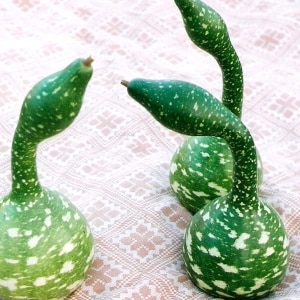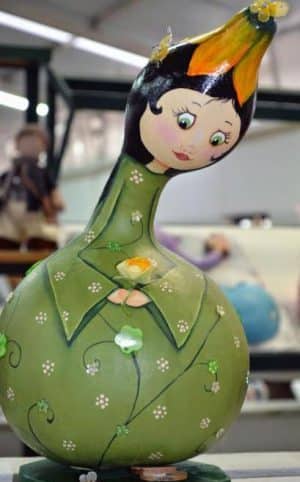Review of the lagenaria variety “Goose in Apples”: what is good and why it is worth growing on your own plot
Cucumber is a familiar green oblong vegetable that decorates various dishes and winter preparations. Have you heard anything about Indian cucumber? Or Vietnamese zucchini? But in nature there is a plant whose fruits are similar to both of these vegetables at the same time.
The article is devoted to the unique variety of lagenaria Goose in apples, which is planted to decorate a summer cottage and for consumption. The variety is named so for a reason: the fruit of lagenaria resembles a goose bending down to nibble grass. Let's get to know him better.
What is lagenaria
Lagenaria is an annual climbing plant of the pumpkin family. Its homeland is India and Vietnam, which is why it is also called Indian cucumber or Vietnamese zucchini.
 Lagenaria fruits are edible only when unripe. They are varied in shape: serpentine, elongated, similar to a huge cucumber or zucchini, jug-shaped, bottle-shaped, and egg-cell shaped. The color of the fruits resembles pumpkin or zucchini and can reach 2 m in length.
Lagenaria fruits are edible only when unripe. They are varied in shape: serpentine, elongated, similar to a huge cucumber or zucchini, jug-shaped, bottle-shaped, and egg-cell shaped. The color of the fruits resembles pumpkin or zucchini and can reach 2 m in length.
Lagenaria also performs a decorative function, entwining gazebos and fences. Lagenaria fruits are suitable for consumption fresh and after cooking.
Reference. Lagenaria stems are used to make baskets and other wickerwork.
Variety Goose in apples
Lagenaria of a fancy shape will decorate your summer cottage, and you can enjoy various dishes prepared from its fruits.
Distinctive features
Characteristic features of Lagenaria Goose in apples:
- heat-loving and moisture-loving plant - in the southern regions it is grown in open ground using seeds, in other areas it is recommended to use the seedling method;
- the seeds are large, with small “horns”;

- a trellis is needed for lagenaria;
- vine-like stems;
- high growth rates - the central shoot grows up to 15 m, lateral shoots - up to 6-8 m;
- the leaves are large, round in shape, bright green in color, velvety to the touch, arranged tightly to each other, covering the support with a single carpet;
- the flowers are large, white, similar to bells, located on long peduncles - the male ones (empty stalks) bloom first, then the female ones, from which the ovaries are formed;
- can bloom and bear fruit at the same time before frost;
- It is distinguished by its unpretentiousness in cultivation and care.
The fruits of the variety Goose in apples are similar in appearance to the fruits of another lagenaria - Geese-swans. However, there are differences in leaf shape and shoot length.
Fruit characteristics
Let's take a closer look at what is typical for lagenaria fruits:
- they resemble a goose gracefully bowing its long neck;
- at the beginning of growth they look like a cucumber;

- after that it looks more like pumpkinthan a cucumber or zucchini;
- when ripe, they look like dark green pumpkins with white speckles;
- Only young fruits are used for food;
- ripe pumpkins are suitable for making decorative vessels - for this, the fruit is peeled from pulp and seeds, and then dried;
- the average fruit size is about 50 cm, weight from 1.5 to 8 kg;
- the plant is unique in that you don’t have to pick the whole fruit, but only cut off the necessary part, and the lagenaria will continue to grow;
- The fruits have excellent taste and can be stored all winter at room temperature.
Fruits that have reached a length of 30-35 cm are suitable for consumption.
Productivity
Considering the ability of lagenaria to bear fruit until the onset of the first frost, the yield of the variety is high. From one bush you can remove from 10 to 15 fruits. Harvesting begins in late summer - early autumn. Fruit ripening lasts 1.5-3 months after pollination.
How to grow
The variety is suitable for cultivation in all regions of Russia. In the south, pumpkin seeds are immediately planted in the ground. In other regions, seedlings are first grown indoors and then transplanted into garden beds.
Planting by seeds
To plant Lagenaria Goose in apples, lightly germinated seeds are used (for this they are placed in growth stimulants - “Epin” or aloe juice). Before planting, the seeds are soaked: placed in a cloth moistened with water and stored in a warm place for several days. It is important to ensure that it remains wet at all times. After 3-4 days, you can plant lagenaria seeds in the ground.
Important! Preparing the soil for planting lagenaria is the same as for pumpkins and zucchini. The only difference is that the soil must be neutral or slightly alkaline.
Seeds are planted in mid-April.
One or more seeds are sown in each hole, at least 5-10 cm deep. When several sprouts appear, only one plant is left, the rest are removed. The distance between holes should be 1 m or more.
To obtain new seeds, some fruits are left on the stems until fully ripe. The seeds are then dried.
Planting seedlings
The process of preparing seeds for growing seedlings is the same as for planting in open ground. Seeds are sown in containers with a volume of at least 1 liter. Peat pots are better suited: each seed is in a separate pot.You can use a common box for planting, and then dive into separate containers. However, lagenaria does not always survive this process successfully.
Young shoots are planted in open ground in mid-May - early June, when night frosts have passed.. The distance between the holes should be 1 m, and the diameter and depth of the holes should be at least 30-40 cm. First, a mixture of 2 tbsp is poured into each hole. l. ash, 500 g of humus and 2 tsp. superphosphate.
You can water the hole with Agricola-5 solution (20 g of the drug per 10 liters of water). Planting should be done carefully to avoid damage to the roots and stems. After planting, the lagenaria is watered with warm water.
Attention! The size of lagenaria for transplanting into open ground should be at least 10 cm.
Choose a sunny, well-lit place for growing lagenaria.
A plant that reaches 1 m in height will need support.
Care
Lagenaria is unpretentious, but requires some care:
- Regular moderate watering is important;
- lagenaria flowers bloom in the dark and close in the morning (only nocturnal insects pollinate it), so it is additionally recommended to use the manual pollination method;
- during growth it is recommended to feed the plant with organic fertilizers;
- to reduce moisture evaporation, the soil is mulched with peat or humus;
- Regular weeding and loosening of the soil are required;
- the stems of the plant require timely pinching and pruning - this stimulates the growth of lateral branches and limits the growth of the main shoot;
- the plant is liana-shaped, it requires supports, which are best placed at a distance of 1.8-2 m from each other (trellis, arches, trees).
Features of cultivation and possible difficulties
For cultivation, fertile soil is used, fertilized with organic and mineral compounds. Acidified and too wet soil is not suitable. Fertilize the soil in the fall.
Lagenaria grows well after legumes, cabbage and potatoes. For planting, it is better to choose a well-lit place, not a shaded one. The plant does not tolerate frost. The optimal temperature is +25 °C.
The growing season of the Goose variety in apples is about 220 days.
When growing lagenaria, you may encounter the following difficulties:
- You may never get any fruits (or there will be 1-2 of them) if you do not use the manual pollination method. The natural overnight method is not enough.
- The fruits dry out after setting. The reason is unsuitable conditions or poor watering.
- Not all seeds planted in open ground or for seedlings can germinate. This happens because the seed skin is very dense.
- The plant may die if night frosts occur after planting in the ground.
Growing tips from experienced gardeners
Summer residents give the following recommendations for growing the Lagenaria variety Goose in apples:
- You can sow seeds for seedlings in a bag intended for preparing compost;
-
To grow lagenaria, you need the sunniest place;

-
to plant seedlings, you need to dig a hole measuring 40x50 cm, fill it with soil mixed with humus (a glass of wood ash and 50-80 g of Ammofoska mineral fertilizer per bucket of humus);
-
fertilize with infusion of chicken manure every 10 days;
-
as a support you can use wire stretched along a fence, gazebo or veranda;
- the support can be natural - a tree or bush;
- with the appearance of the first flowers, it is necessary to carry out hand pollination - pick a male flower, bring it to the female one and touch it with the stigma stamens;
- so that the “neck” of the fruit is not bent, but elongated, the fruits are hung.
Diseases and pests
Lagenaria is affected by the same diseases and pests as other members of the pumpkin family.
Diseases:
- Anthracnose. A fungal disease that appears as light brown spots on leaves and stems. Leads to fruit ulceration. High air humidity promotes the development of the disease.
- Root rot. Refers to fungal diseases. Characteristic signs are wilting of leaves followed by death of roots. The reason is the sharp changes in night and day temperatures.
- Gray rot. Large brown spots appear on the leaves, a gray fluffy coating appears on the fruits, and the stems begin to rot.
- Powdery mildew. Fungal disease. It appears as a white or reddish coating on the front side of the leaves, which leads to their drying out. The reason is excessive moisture.
- Downy mildew, or downy mildew. Light, then brownish spots appear on the upper side of the leaves. On the underside, a grayish-violet coating is noticeable in places where there are spots.
Read also:
Causes and treatment of anthracnose in cucumbers.
Calcium nitrate against blossom end rot.
Why does powdery mildew appear on cucumbers and why is it dangerous?
Pests:
- Slugs and snails. They feed on young shoots and leaves of plants.
- Whitefly. A small yellowish insect with white wings, no more than 2 mm in size. Causes damage to plants by sucking juice from leaves.
- Armyworm larvae. Butterfly caterpillars feed on leaves.
- Fall armyworm larvae. Caterpillars cause damage to young shoots and leaves.
- Aphid. A widespread insect, it develops in moderately humid and warm weather. It can be found on the backs of leaves, stems and flowers. It feeds on lagenaria juice. If the damage is significant, the plant may dry out and die.
- Spider mite. Sucks out the sap of the plant. Signs - a thin cobweb appears on the underside of the leaves, the leaves gradually become brown in color and subsequently dry out. The reason is hot and dry weather.
Harvesting and application

Not all types of lagenaria have edible fruits. The variety Goose in apples has young fruits (up to 50 cm) that are tasty, tender and juicy, reminiscent of a cucumber or zucchini. They can be eaten raw or prepared into salads. More mature fruits are usually used for making soups, pancakes, stews and fried dishes. You can prepare caviar and various snacks from them. Lagenaria fruits are good when baked, salted and pickled.
Lagenaria Goose in apples is a valuable dietary product. Eating fruits helps cleanse the body of toxins, heavy metals, toxins, radionuclides, salts, improves metabolic processes, reduces blood pressure, and strengthens the immune system.
The seeds are used as a folk remedy for removing worms.
Ripe fruits can be used in arts and crafts: make vases, jugs and other vessels, use for making crafts, for interior decoration. The stems can be used to weave original and durable baskets.
Advantages and disadvantages of the variety
The main advantages of Lagenaria Goose in apples:
- good yield;
- disease resistance;
- originality of appearance;
- refinement of taste;
- nutritional value;
- unpretentiousness;
- possibility of use for decorative purposes;
- duration of storage of collected fruits.
Disadvantages include the inability to grow a plant without heat and good light, and the need for manual pollination.
Farmer reviews
Lagenaria Goose in apples is most often grown by summer residents for decorative purposes.
Iliad, Kaluga: «Lagenaria Goose in apples is an interesting vegetable. Due to the fact that the fruits were initially in a suspended state, they acquired the shape of a club. The young fruits are edible and taste similar to zucchini, but it’s a pity to eat such beauty; it’s better to use it for making unusual vases, because lagenaria is a tableware pumpkin. It grows quickly, so it is perfect for quickly greening up an area. It has luxurious large leaves, fragrant white flowers and funny fruits. I grew the plant using seedlings, but you can also plant it using pecked seeds. It doesn’t require much care, it can suppress weeds on its own, but watering and fertilizing are desirable, but even without this, lagenaria grows and bears fruit well.”
Victor, Gornyak-1: “I grew several varieties of lagenaria, including Goose in apples. I think the last one is the most original. The fruits look like geese grazing. The plant itself is very beautiful.”
Nadezhda, Orel: “I grew Lagenaria Goose in apples, using rosehip bushes as a support. Grown for the purpose of making bird houses. I bought several bags of seeds from Gavrish for planting. I planted a lot, but not all of them sprouted. I encountered the following problem: some fruits, before they had time to set, dried out. But all the same, the entire rosehip was dotted with “geese”.
Conclusion
Lagenaria Goose in apples is not only an ornamental plant, but also a nutritious and valuable vegetable.By planting it on your plot, you can not only admire the beautiful “geese”, but also use the fruits and stems for food and for making crafts.
The main thing is to follow simple rules of agricultural technology and monitor plantings. Have a beautiful and delicious harvest!